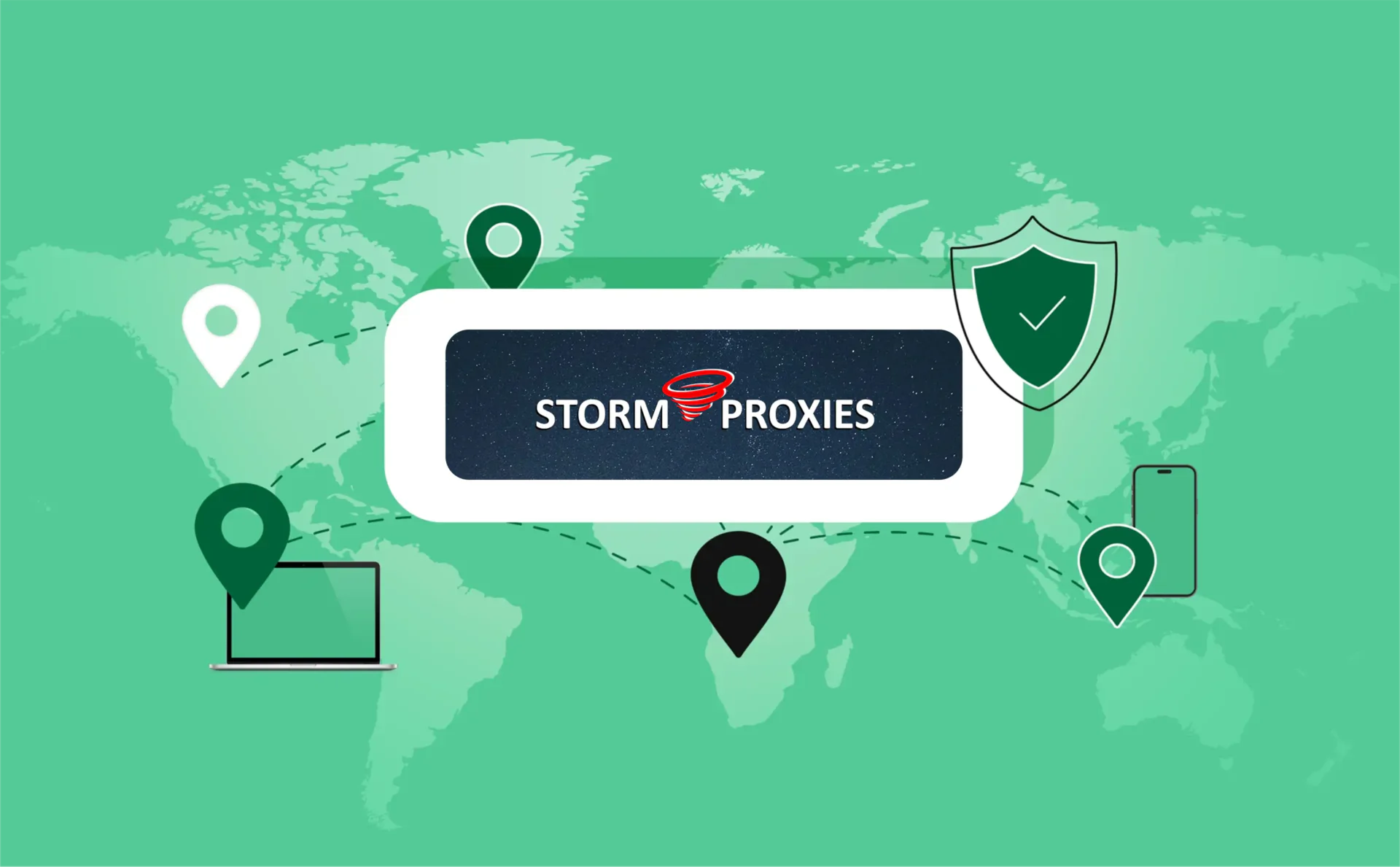
Storm Proxies Review (2025): Affordable Rotating Proxies—Great Value or False Economy?
When you start scraping data, managing dozens of social media accounts, or running sneaker bots, you quickly discover how unreliable free proxies can be. Blocks, bans, and connection drops become part of the routine. That’s usually when you look at paid services — and Storm Proxies is one of the first budget names you’ll hear.
I tested Storm Proxies in real scenarios (scraping, SEO tools, and social media logins). Below, I’ll show how the service works, where it shines, where it struggles, and whether it deserves a place in your toolkit.
Not sure what proxies are or why they matter? Start with our beginner-friendly guide on what is a proxy.
What Makes Storm Proxies Different?
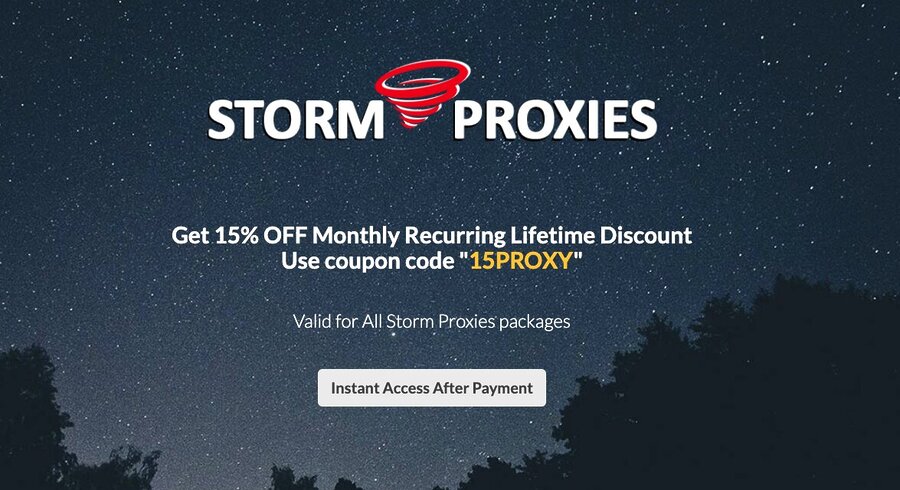
Storm Proxies has been around since 2016, leaning into simplicity and affordability rather than enterprise-level dashboards. You get a minimal interface, quick delivery, and unlimited bandwidth across plans. Instead of charging per gigabyte, they charge per port or thread, which makes pricing predictable and beginner-friendly.
It’s tailored to a niche audience: solo marketers, sneaker resellers, ticket buyers, SEO freelancers, and hobby scrapers who want working IPs without the heavy bill.
A user on Reddit summed it up well:
“I’ve used Storm Proxies for scraping projects and the simplicity is what sold me. It’s not the fastest provider out there, but for the price, it works great if you’re careful with your requests.”
f you’re new to proxies and want to understand how IP rotation actually works, check out our guide on what is a rotating proxy.
How I Tested Storm Proxy (quick but honest)
I ran a 10-hour test on rotating residential proxies (5 ports), scraping U.S. e-commerce and news sites at 30–60 requests per minute using Scrapebox and Python scripts. I tracked success rates, median response times, CAPTCHA encounters, and observed how often blocks appeared.
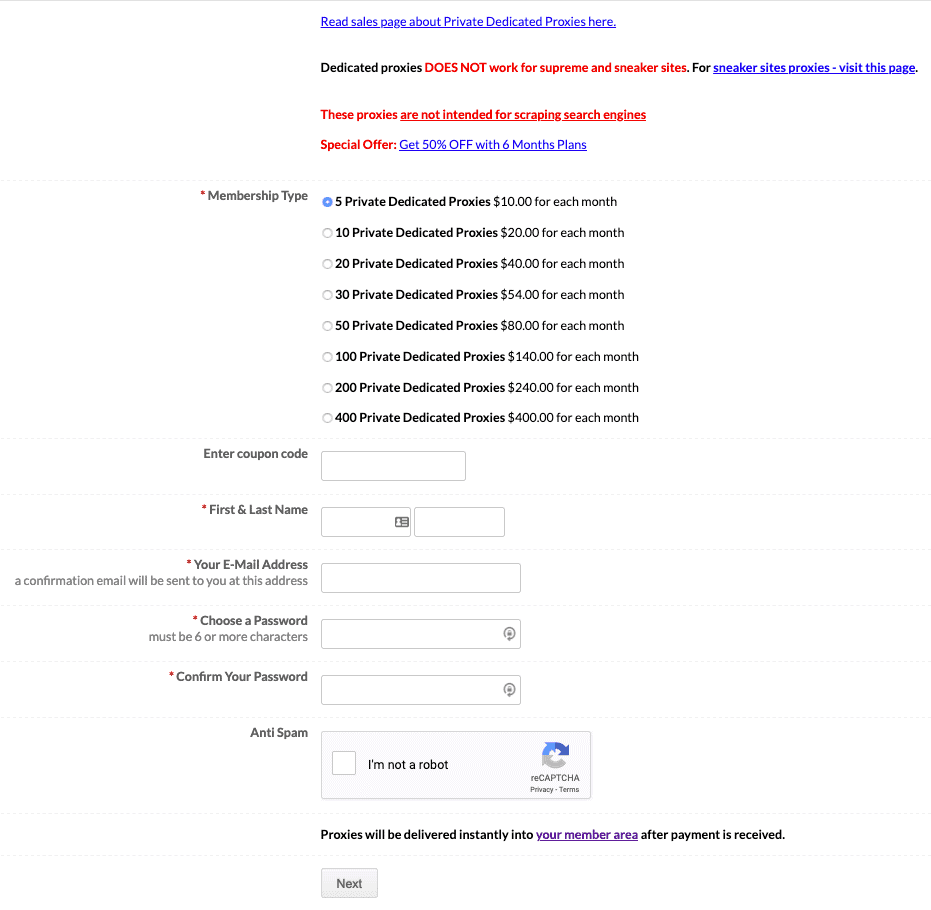
Results will vary by site and concurrency, but this gives a fair picture of what to expect in real use.
Storm Proxies Capabilities & Limits
| Area | What you get | What to expect |
| Proxy types | Rotating residential; backconnect rotating (per request / 3 min / 15 min); dedicated datacenter | Choose rotation cadence based on task |
| Rotation cadence | Every request, 3 minutes, 5 minutes, or 15 minutes | Works for scraping or longer sessions |
| Geo options | USA, EU, USA+EU, “Worldwide” gateways | No city-level targeting |
| Protocols | HTTP/HTTPS only | No SOCKS5 support |
| Authentication | IP allowlisting; user/pass on some datacenter plans | Residential usually limited to 1 allowlisted IP |
| IP pool size | ~700,000 residential IPs | Smaller than premium competitors |
| Refund | 24-hour money-back on smallest plans | Test small before upgrading |
| Bandwidth | Unlimited on all plans | Costs scale with ports/threads |
Pricing & Storm Proxies Coupon
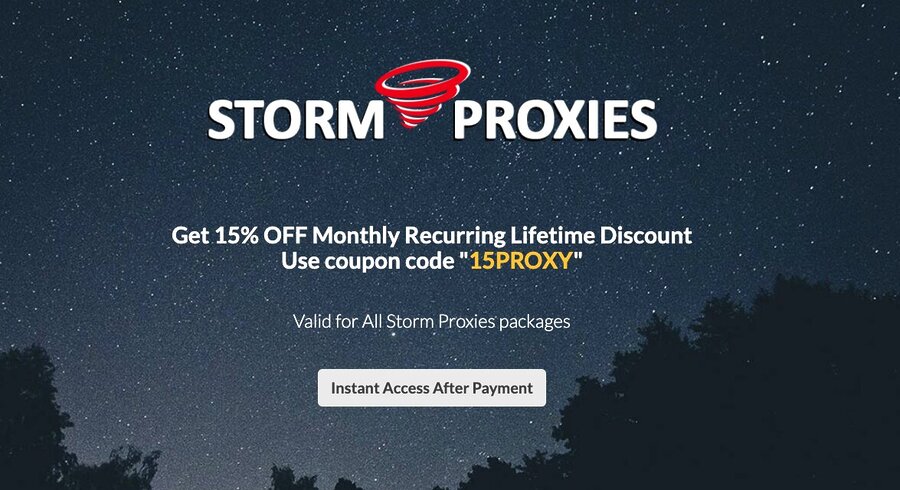
Storm Proxies is one of the cheapest paid proxy providers available. Here’s how plans are structured:
- Rotating Residential Proxies: start at $19 for 1 port, $50 for 5 ports, scaling up to $300 for 50 ports. IPs rotate every 5 minutes.
- Backconnect Rotating Proxies: begin around $39/month for 40 threads, with rotation options per request, 3 minutes, or 15 minutes.
- Dedicated Datacenter Proxies: as low as $10/month for 5 IPs.
Every plan includes unlimited bandwidth. Instead of worrying about data caps, you only manage how many ports or threads you need.
Looking for a way to save on your Storm Proxies subscription? Keep an eye out for official coupons during promotions. While occasional deals may appear online, the safest place to find active offers is always the Storm Proxies pricing page.
Current Active Deal
15% OFF Lifetime Discount on All Storm Proxies Packages
- Coupon Code: 15PROXY
- Where to Apply: Enter the code at checkout on the order page
- Benefit: Save 15% on your monthly plan, for as long as you remain subscribed
- Limit: Valid for one package per client
Start saving today by applying the coupon when you purchase your Storm Proxies plan.
How to Use Storm Proxies
If you’re wondering how to use Storm Proxies, the setup is quick:
- Sign up on the official site.
- Access your dashboard through the Storm Proxy login page.
- Whitelist your IP (or set up username/password if your plan allows).
- Copy the provided proxy IP and port.
- Paste them into your browser, bot, or SEO tool.
In my experience, I was scraping within minutes of purchase. No complicated API integrations or steep learning curve — just copy and paste.
My Experience With Storm Proxies
- Web scraping: For small to medium jobs, success rates were good. On heavily protected websites, I did see more CAPTCHAs compared to premium providers.
- SEO tools: Tools like Scrapebox ran smoothly, and unlimited bandwidth meant I never worried about usage caps.
- Social media: Facebook and Instagram logins worked well on residential proxies. For large numbers of accounts, warming up gradually was essential.
Overall, the proxies delivered what they promised. Performance wasn’t uniform across all sites, but that’s expected at this price tier.
Storm Proxies vs Competitors
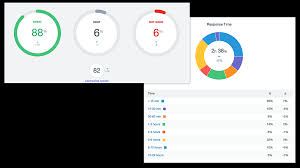
How does Storm Proxies stack up against others?
- Bright Data / Oxylabs: Massive IP pools and advanced features, but far more expensive.
- Smartproxy / Soax: Broader geo-targeting and stronger dashboards, but higher entry prices.
- Storm Proxies: Fewer features, smaller pool, but among the cheapest — ideal for lighter workloads.
Storm Proxies isn’t trying to be enterprise-level. It’s a budget-friendly option for users who value price and simplicity.
Already using Storm Proxies or another proxy provider?
Privacy & Trust Considerations
Storm Proxies’ privacy policy is short and doesn’t provide as much detail as enterprise services. That means users should take a cautious approach: test on a small plan first and avoid sending highly sensitive data through the proxies.
Public reviews are mixed — some users complain about detectable IPs or slow support, while others praise the affordability and 24-hour refund policy. It reinforces the advice: start small, then scale if it fits your workflow.
Pros and Cons
Pros
- Unlimited bandwidth on all plans
- Affordable pricing starting at $10/month
- Instant delivery and simple storm proxy login dashboard
- Rotating residential proxies reduce bans
Cons
- No SOCKS5 support (HTTP/HTTPS only)
- Smaller IP pool than big competitors
- Limited geo options (U.S./EU only)
- Support may be slower at peak times
Who Should Use Storm Proxies?
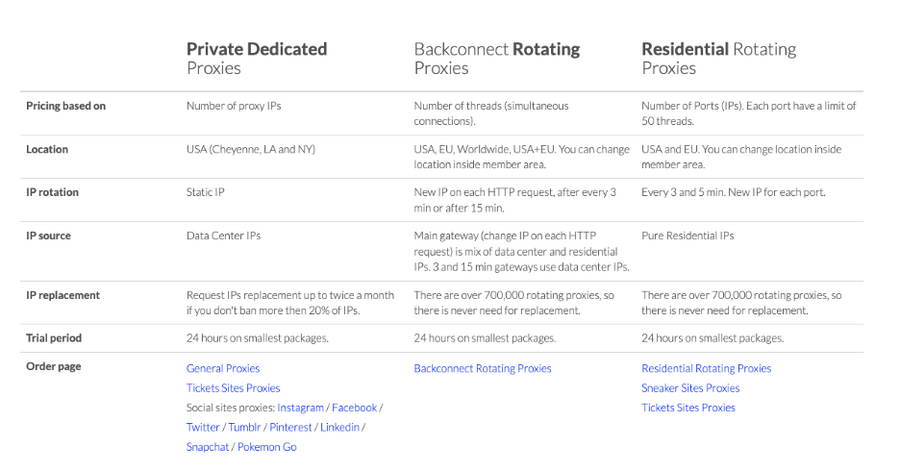
Alt text: Storm Proxies package comparison chart of features and limits.
Storm Proxies won’t be the right tool for everyone. If you’re a data scientist scraping millions of pages daily across dozens of countries, you’ll quickly outgrow it.
Best for:
- Sneaker reseller who needs rotating residential proxies for drops
- SEO professional who runs Scrapebox or GSA SER campaigns
- Social media manager juggling multiple accounts safely
- Beginner scraper who just wants a plug-and-play option
…then Storm Proxies is a solid, cost-effective choice.
Not ideal for:
- Enterprises needing fine geo-targeting or SOCKS5
- High-volume scrapers requiring millions of IPs
- Users who expect live chat or instant support
For me, the real value lies in the predictable pricing model. Unlimited bandwidth means I don’t have to worry about hitting a GB cap mid-campaign. Storm Proxies isn’t a magic bullet — but it doesn’t pretend to be. What it does offer is a fair balance: predictable pricing, simple setup, and a service that’s good enough for most scrapers, marketers, and resellers. If you go in with realistic expectations, it’s one of the few budget proxy providers that can actually back up its promises.
FAQ
How do I log in to Storm Proxies?
After you purchase a plan, go to the Storm Proxies login page and enter your username (or email) and password. Once you’re in, you’ll be taken to your dashboard. Inside your dashboard, you can:
- View and manage your proxy list, including rotating or dedicated ones
- See which ports you own, activate or deactivate them
- Set up IP whitelisting (Authorized IPs) so the proxies only work from specific IPs
- Monitor usage and see your bandwidth or port activity
If you didn’t receive login details, check your email’s spam folder. If still nothing, contact support.
Do Storm Proxies offer free trials or refunds?
Storm Proxies doesn’t give a free trial in the usual sense (i.e. use the service without paying). But they do offer a risk-free period:
- For their smallest package in each proxy type, you can get a 24-hour money-back guarantee.
- You purchase, test the proxies (use them in your scenario), and if you aren’t happy, email their support within those first 24 hours for a refund.
This lets you try before committing to a larger plan. If you plan to scale, it’s wise to start with the cheapest plan to test performance and reliability.
Can Storm Proxies be safely used for social media and managing multiple accounts?
Yes — many users rely on Storm Proxies for social media tasks (e.g. managing multiple Instagram, Facebook, TikTok accounts) because of these benefits and caveats:
Why people use them:
- IP rotation helps avoid detection. Using fresh IPs reduces chances of bans.
- Dedicated and residential proxies provide more “realistic” IPs, which social platforms are less likely to block.
- Ability to whitelist specific IPs helps maintain stable access.
Important practices to follow for safety and effectiveness:
- Warm up new accounts — don’t immediately start heavy actions (e.g. lots of follows, messages)
- Use different profiles/devices where possible (cookies, browser fingerprints, etc.)
- Ensure your proxy plan supports a stable connection speed
- Rotate posts or activities so your pattern looks natural
If done properly, Storm Proxies is a legitimate solution for multi-account social media management, avoiding frequent bans or blocks.
How much do Storm Proxies cost?
Storm Proxies pricing varies depending on proxy type (residential rotating vs dedicated datacenter), number of ports, and access (USA, EU, etc.). Here’s a breakdown to give you a clear picture:
- Residential rotating proxies start at about $50/month for 5 ports. As you buy more ports, the per-port cost drops.
- For example, 5 ports ≈ $50, 10 ports ≈ $90, 20 ports ≈ $160, and 50 ports ≈ $300 monthly.
- Dedicated/private proxies tend to start lower per IP since they aren’t rotating as often, but they also don’t come with the same “fresh” IP rotation benefits.
- All plans include unlimited bandwidth, so you’re not charged based on data usage — you’re charged based on the number of ports or proxies.
If you’re trying them out, starting with the small plan lets you test performance and reliability without committing to a large cost.
What is the size of Storm Proxies’ IP pool and how is rotation handled?
Storm Proxies claims a residential IP pool of about 700,000+ rotating IPs for their residential (backconnect) plans. As for rotation:
- Residential IPs on those plans rotate approximately every 5 minutes by default.
- You choose a gateway port, which you integrate into your scraping tool or bot, and the “gateway” gives you a fresh IP every rotation period.
- For fixed/dedicated proxies, the IP does not rotate (you use one IP).
So you get both options: fast‐rotating IPs for high anonymity / scraping tasks, or static IPs for things like login-heavy work or where consistency is more important.
How does Storm Proxies’ performance compare to others?
Compared to larger proxy providers, Storm Proxies has both pros and cons:
Pros:
- Very competitive pricing for smaller-scale users.
- Unlimited bandwidth is a big plus — you won’t hit data caps.
- Good ease of setup and instant delivery of proxies once you pay.
Cons:
- IP pool is decent but not as large as providers that offer tens of millions of IPs. That means more chance of IP reuse or getting blocked if you have very aggressive scraping tasks.
- Fewer geographic targeting options beyond USA/EU; not much city-level or ISP-level geo-filtering.
- For sites with strong anti-bot or CAPTCHA protections, Storm Proxies may sometimes struggle more than top-tier providers.
Which plan is best for sneaker sites or ticketing sites?
If your main use case is sneaker releases, limited-edition drops, or high-traffic ticket sales, you need speed, IP rotation, and reliability. Here’s what to look for in a plan:
- Choose a residential rotating plan or a backconnect rotating proxy gateway. Those are harder to block and more “natural” in the eyes of sneaker/ticketing sites.
- Prioritize plans with fast rotation (short intervals) so IPs don’t get flagged.
- A dedicated port or proxy is helpful so you don’t share issues caused by other users.
- Ensure the plan includes “sneaker site” / ticket-site proxies or is optimized for sites known to be tough, like Nike, Adidas, Ticketmaster.
Storm Proxies provides specialized plans labeled for sneaker sites or ticket sites; those are usually your best bet.
Do Storm Proxies support authentication by username/password?
Yes. Storm Proxies supports both IP authentication and username/password authentication, depending on your setup.
Is Storm Proxies good for SEO tools?
Absolutely. Many SEO professionals use Storm Proxies for tools like Scrapebox, GSA SER, and other link-building or keyword analysis software because of the unlimited bandwidth model.
Is Storm Proxies safe and legal?
Using proxies is legal. However, it depends on how you use them. Activities like scraping public data or running automation are fine, but illegal activities remain your responsibility.
Final Verdict: Is Storm Proxies Worth It?
Storm Proxies isn’t built to compete with giants — but it doesn’t have to. For small to medium projects, it delivers a reliable mix of affordability, unlimited bandwidth, and easy setup.
If you go in with realistic expectations, it’s one of the few budget proxy providers that actually does what it says. Try the smallest plan, use the refund option if it doesn’t fit, and if it works — you’ve found a cost-effective solution.